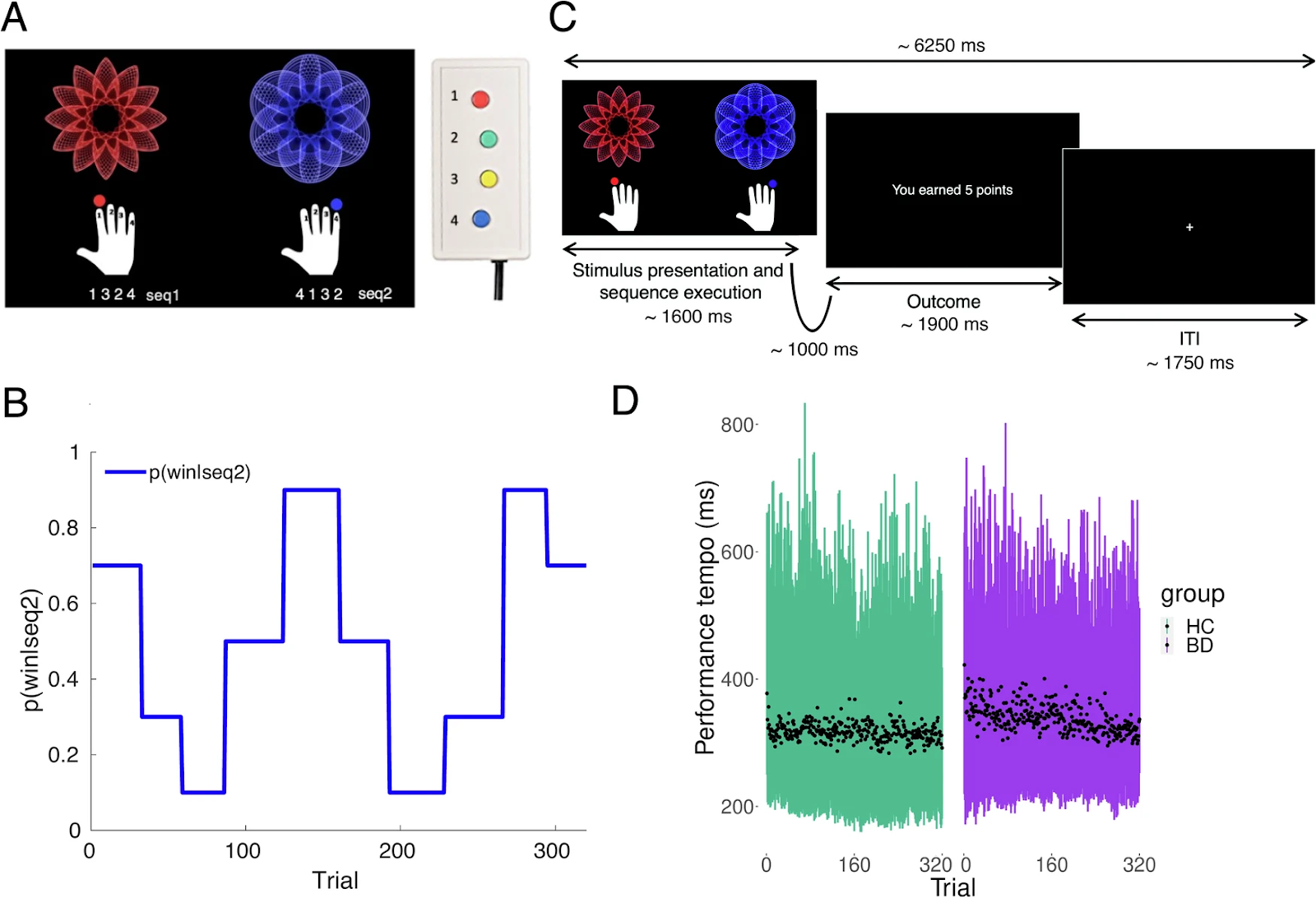Scientists Reveal Cognitive Mechanisms Involved in Bipolar Disorder

An international team of researchers including scientists from HSE University has experimentally demonstrated that individuals with bipolar disorder tend to perceive the world as more volatile than it actually is, which often leads them to make irrational decisions. The scientists suggest that their findings could lead to the development of more accurate methods for diagnosing and treating bipolar disorder in the future. The article has been published in Translational Psychiatry.
Bipolar disorder (BD) is a chronic affective condition characterised by alternating episodes of extreme elation (mania) and severe depression. According to the WHO, an estimated 40 million people worldwide live with bipolar disorder, but diagnosing the condition can be challenging, as its symptoms are not always apparent.
Studies show that individuals with bipolar disorder, even during remission, exhibit specific behavioural and brain activity patterns that may indicate the condition. In particular, patients with bipolar disorder have been found to exhibit impairments in their decision-making processes. Normally, when making a decision, a person tries to choose the option that offers the greatest reward. If the choice proves to be correct, they are likely to make the same decision again next time. However, circumstances can change, requiring a person to reassess which option offers the greatest benefit. Patients with BD often struggle to recognise when it is necessary to adjust their decision-making strategy.
A group of researchers from HSE University, Sechenov University, the Max Planck Institute, and Goldsmiths, University of London, conducted an experiment to investigate how individuals with bipolar disorder adapt to environmental changes and make decisions.
The study included 22 bipolar patients in remission and 27 healthy volunteers who served as the control group. Participants were instructed to earn as many points as possible by selecting either a blue or red image on a computer screen. Each option had a certain probability of winning, which changed throughout the experiment. For example, initially the blue image won 70% of the time, but later its winning probability dropped to 30%. Throughout the experiment, participants’ neuronal brain activity was monitored using magnetoencephalography (MEG).

Marina Ivanova
'This experimental design mimics real-world conditions, which are also full of uncertainties and require constant decision-making—even in everyday situations. For example: should you pet a cat, or is it better not to? Will it purr or scratch? We try to anticipate the consequences of our choices and make the best decision accordingly,' explains Marina Ivanova, Junior Research Fellow at the HSE Institute for Cognitive Neuroscience and primary author of the study.

The results of the experiment showed that participants with bipolar disorder perceived the environment as more volatile than it actually was, which often led them to make incorrect choices.
'If a person makes a decision and it turns out to be the right one, they will likely repeat that choice next time. However, someone with bipolar disorder may change their strategy even after a successful outcome,' says Ivanova.
The scientists also observed neural differences in brain regions involved in decision-making, specifically the medial prefrontal, orbitofrontal, and anterior cingulate cortices. At the neural level, while healthy individuals exhibited alpha-beta suppression and increased gamma activity during the experiment, participants with bipolar disorder showed dampened effects.
'Our study reveals that even outside of manic or depressive episodes, people with bipolar disorder process information about environmental changes differently. They constantly anticipate changes but struggle to properly learn from them when they occur. As a result, their decisions are more spontaneous and unpredictable than those of the control group,' comments Ivanova. ‘However, it is important to remember that our experiment only simulates real life, so we should be cautious when applying these findings to actual everyday situations.'
The results may be useful for developing models to diagnose bipolar disorder and predict its recurrence. In the future, this approach could be adapted to other mental health conditions involving adaptive learning impairments and may also serve as an important step toward advancing computational psychiatry.
See also:
Scientists Test Asymmetry Between Matter and Antimatter
An international team, including scientists from HSE University, has collected and analysed data from dozens of experiments on charm mixing—the process in which an unstable charm meson oscillates between its particle and antiparticle states. These oscillations were observed only four times per thousand decays, fully consistent with the predictions of the Standard Model. This indicates that no signs of new physics have yet been detected in these processes, and if unknown particles do exist, they are likely too heavy to be observed with current equipment. The paper has been published in Physical Review D.
HSE Scientists Reveal What Drives Public Trust in Science
Researchers at HSE ISSEK have analysed the level of trust in scientific knowledge in Russian society and the factors shaping attitudes and perceptions. It was found that trust in science depends more on everyday experience, social expectations, and the perceived promises of science than on objective knowledge. The article has been published in Universe of Russia.
Scientists Uncover Why Consumers Are Reluctant to Pay for Sugar-Free Products
Researchers at the HSE Institute for Cognitive Neuroscience have investigated how 'sugar-free' labelling affects consumers’ willingness to pay for such products. It was found that the label has little impact on the products’ appeal due to a trade-off between sweetness and healthiness: on the one hand, the label can deter consumers by implying an inferior taste, while on the other, it signals potential health benefits. The study findings have been published in Frontiers in Nutrition.
IDLab: Fascinating Research, Tough Deadlines, and Academic Drive
The International Laboratory of Intangible-driven Economy (IDLab) was established at the HSE campus in Perm 11 years ago. Its expertise in data processing and analysis allows researchers to combine fundamental studies with applied projects, including the development of risk and cybersecurity models for Sber. The head of the laboratory, Professor Petr Parshakov, and Senior Research Fellow Professor Mariya Molodchik spoke to the HSE News Service about IDLab’s work.
HSE Psycholinguists Launch Digital Tool to Spot Dyslexia in Children
Specialists from HSE University's Centre for Language and Brain have introduced LexiMetr, a new digital tool for diagnosing dyslexia in primary school students. This is the first standardised application in Russia that enables fast and reliable assessment of children’s reading skills to identify dyslexia or the risk of developing it. The application is available on the RuStore platform and runs on Android tablets.
Physicists Propose New Mechanism to Enhance Superconductivity with 'Quantum Glue'
A team of researchers, including scientists from HSE MIEM, has demonstrated that defects in a material can enhance, rather than hinder, superconductivity. This occurs through interaction between defective and cleaner regions, which creates a 'quantum glue'—a uniform component that binds distinct superconducting regions into a single network. Calculations confirm that this mechanism could aid in developing superconductors that operate at higher temperatures. The study has been published in Communications Physics.
Neural Network Trained to Predict Crises in Russian Stock Market
Economists from HSE University have developed a neural network model that can predict the onset of a short-term stock market crisis with over 83% accuracy, one day in advance. The model performs well even on complex, imbalanced data and incorporates not only economic indicators but also investor sentiment. The paper by Tamara Teplova, Maksim Fayzulin, and Aleksei Kurkin from the Centre for Financial Research and Data Analytics at the HSE Faculty of Economic Sciences has been published in Socio-Economic Planning Sciences.
Mistakes That Explain Everything: Scientists Discuss the Future of Psycholinguistics
Today, global linguistics is undergoing a ‘multilingual revolution.’ The era of English-language dominance in the cognitive sciences is drawing to a close as researchers increasingly turn their attention to the diversity of world languages. Moreover, multilingualism is shifting from an exotic phenomenon to the norm—a change that is transforming our understanding of human cognitive abilities. The future of experimental linguistics was the focus of a recent discussion at HSE University.
Larger Groups of Students Use AI More Effectively in Learning
Researchers at the Institute of Education and the Faculty of Economic Sciences at HSE University have studied what factors determine the success of student group projects when they are completed with the help of artificial intelligence (AI). Their findings suggest that, in addition to the knowledge level of the team members, the size of the group also plays a significant role—the larger it is, the more efficient the process becomes. The study was published in Innovations in Education and Teaching International.
New Models for Studying Diseases: From Petri Dishes to Organs-on-a-Chip
Biologists from HSE University, in collaboration with researchers from the Kulakov National Medical Research Centre for Obstetrics, Gynecology, and Perinatology, have used advanced microfluidic technologies to study preeclampsia—one of the most dangerous pregnancy complications, posing serious risks to the life and health of both mother and child. In a paper published in BioChip Journal, the researchers review modern cellular models—including advanced placenta-on-a-chip technologies—that offer deeper insights into the mechanisms of the disorder and support the development of effective treatments.


